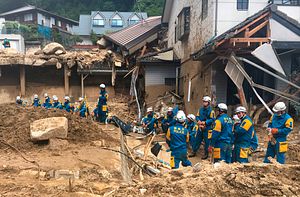One year after heavy rains brought about the worst flooding in Japan’s Heisei Era, memorial services were held across western Japan last week remembering the 275 victims who lost their lives. But this year’s unprecedented downpours are bringing severe flood warnings that could exceed last year’s torrential rains in west Japan.
On Japan’s southernmost island of Kyushu, Fukuoka, Kumamoto, and Kagoshima prefectures received a torrential rain warning from local governments, which prompted evacuation advisories for over 1.2 million people. With rainfall exceeding 100 centimeters and heavy rains continuing for several hours, Kagoshima was placed on a high mudslide alert and communities were urged to evacuate early to prevent being stranded.
However, despite evacuation warnings for areas within Kagoshima and Miyazaki, records show only 6,301 people utilized the 820 emergency shelters prepared during the heavy rains. Ultimately, a woman in her 70s died after being trapped by a landslide that engulfed her home in Kagoshima.
Although the predicted stormy weather has settled down, heavy rains were expected to pick up on Sunday, battering Kyushu and the Kanto region surrounding Tokyo. The Japan Meteorological Agency urged residents in low-lying areas who plan to drive over the long weekend to stay vigilant against submerged roads, swollen rivers, and landslides. Last week overflowing rivers, closed roads, and poor driving conditions stranded delivery trucks, leaving some convenience stores in Kagoshima empty and unable to restock food supplies.
An increase in abnormal weather patterns has prompted calls for improved crisis management and effective evacuation stages. Interviews with locals revealed that the magnified death toll from last year’s flood disaster in west Japan was a combined result of miscommunication, a lack of understanding of the weather warnings and the severity of evacuation stages, as well as evacuation orders being issued last minute. The issue of whether the elderly and children can be safely evacuated has also been raised, with data suggesting that elderly residents are less inclined to heed evacuation orders due to mobility restrictions.
On Friday the first “flood disaster summit” was attended by representatives from all 143 municipalities of Japan to discuss how to prevent delayed emergency evacuation orders. Local governments have also requested funding to host briefing sessions to help residents understand the importance of independently evacuating without relying on government instruction.
In light of heighted community anxiety, Tokyo’s eastern ward of Edogawa has prepared a flood hazard booklet in consultation with experts and residents. The 33-page flood hazard map was distributed to all households in Edogawa, detailing the flood zones and evacuation methods. The entire area is predicted to flood for up to two weeks when storm surges and floods, occur putting at risk some 700,000 people who will be forced to evacuate to the prefectures surrounding Tokyo such as Chiba, Saitama, Kanagawa, and Ibaraki. Edogawa has so far held six local information sessions, attracting 600 residents, to reduce confusion and address questions relating to services that will be on offer at a time of a disaster.
It’s also the first time five local Tokyo municipalities — Edogawa, Sumida, Koto, Adachi, and Katsushika — have joined forces to consider large-scale flood damage and the mass evacuation of roughly 2.5 million residents due to worsening floods from powerful typhoons. Water is expected to reach the fourth floor of buildings, putting lives at risk if residents flee to the upper floors of buildings with no access to water, food, and sanitation. Edogawa is expected to take the lead in creating an evacuation system and securing evacuation sites for, at this stage, one million of its residents.
Last year’s torrential rains that triggered floods and landslides recorded the highest death toll since the devastating 1982 Nagasaki floods. Hiroshima, Okayama, and Ehime prefecture were the hardest hit, experiencing enormous flood damage. Currently in Hiroshima more than 9,200 people are still living in temporary evacuation accommodations.
































